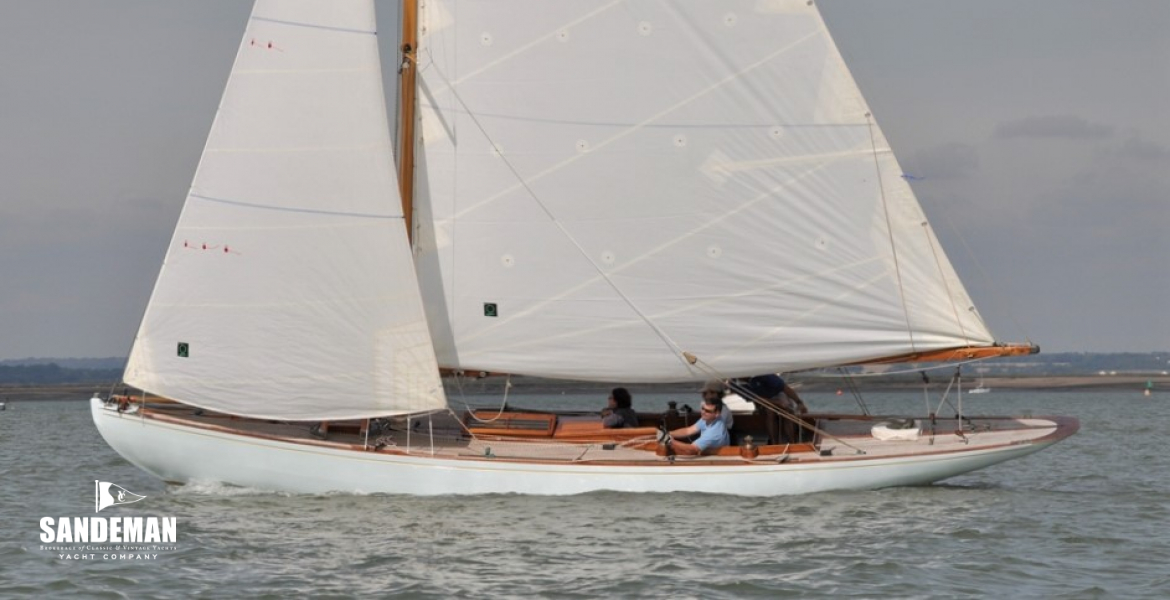
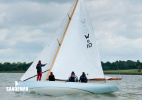
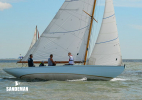
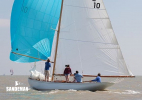
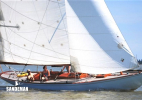
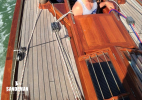
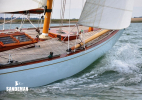
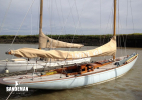
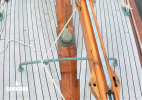
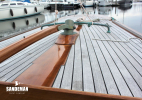
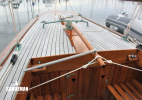
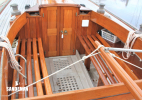
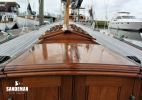
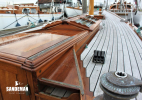
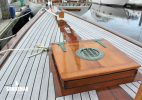
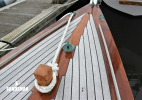

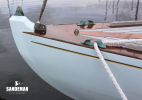
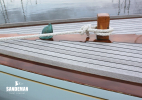
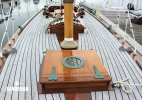
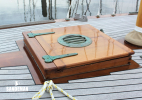
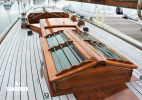
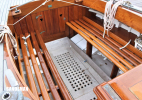
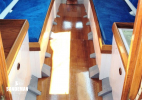
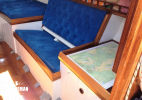

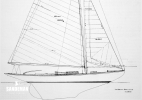
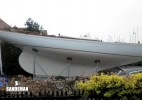
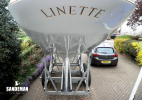
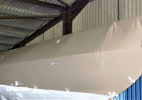
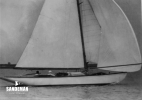
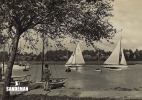
| Designer | H G May |
|---|---|
| Builder | Berthon Boat Co Ltd |
| Date | 1925 |
| Length overall | 35 ft 0 in / 10.67 m |
| Length deck | 35 ft 0 in / 10.67 m |
| Length waterline | 24 ft 0 in / 7.32 m |
|---|---|
| Beam | 7 ft 7 in / 2.31 m |
| Draft | 5 ft 4 in / 1.63 m |
| Displacement | 4.5 Tonnes |
| Construction | Carvel, pine on oak |
| Engine | - |
|---|---|
| Location | United Kingdom |
| Price | Sold |
These details are provisional and may be amended
LINETTE is one of the finest examples of this iconic class of beautifully simple racing and weekending sloops. The tough but elegant and perfectly balanced West Solent is a delight both to sail - under a substantial yet very manageable rig - and just to be aboard, and capable of winning on handicap at both classic events or against more modern yachts. LINETTE was rebuilt 1995-96. Subsequently she's been carefully used and stored inside most winters. From 2011 she has been included in the UK National Register of Historic Vessels. More recently the present interior was fitted 2012-13 and she comes with her own local transport trailer.
Interested in LINETTE in more detail.
1995-96
- Fully restored to concourse (new) condition by Peter Brookes of Maldon
- Peter had restored several West Solents, but this one was firmly his boat
- He gave LINETTE's restoration a little extra special attention
- And a teak deck
2012-13
New interior - see below
In 1924 the 'W' Boats were conceived by HG May of the Berthon Boat Company in Lymington as one-design cruiser racers. Five boats were initially commissioned by members of The (Royal) Lymington Yacht Club and became better known as the West Solent Restricted Class. During the following six years a further 25 boats were built, until the depression of the 'thirties put an end to further commissions in Britain. Five additional boats were built and shipped to Argentina for the Yacht Club Argentino, and in 1934 VALIANT, now broken up, was built under licence in Bombay. The (Royal) Burnham Yacht Club adopted the Class where they were known as the (Royal) Burnham Restricted Class and a number of boats were also based at Torbay and Aldeburgh. These "W" Boat Divisions sailed around the coast participating in the various regattas and also team raced against each other. The sail number indicated the Division to which each boat belonged, thus 'W' was from Lymington, 'WB' from Burnham and 'WT" from Torbay.
Although much the same size as a 6-Metre, the W Boat weighs about a ton more, being just under five tons, and as a result feels more powerful. They are the thirty five feet cruiser racer that some yachtsmen had hoped the International (Metre Boat) Rule would produce when it was created in 1907, but the smallest boat with accommodation built to that Rule is the near 50 ft 8-Metre.
The "W" Boats were one of the first production racers and according to Berthon's promotional literature were laid down in batches: "A very complete and carefully made set of moulds, jigs and templates enables us to produce these standard hulls with exceptional uniformity at a cost little more than half that of designing and building individual boats of similar size and type.” They were delivered afloat at Lymington for £600. By comparison, a 6-Metre at that time cost around £1,500, but generally boasted superior workmanship and materials. These Ws were knockabout racing boats although built in accordance with Lloyd's requirements for cruising yachts of those dimensions. They had two bent timbers of Canadian rock elm spaced every 23 inches, between a pair of oak sawn frames. Wrought iron floors were strapped on the frames. The planking was red pine, and 39 hundredweight of lead hung on an English elm wood keel. The deck was tongue and groove pine covered with canvas.
In the beginning the Owners Club decided upon a Restricted Class because they were popular in the twenties and thirties. The 'Sixes' made the transition from gaff or gunter to Bermudan rig between 1919 and 1920, but in 1924 the 'Eights' were still racing with gaff rigs and bowsprits. It was thought a restricted class would promote development, and keep the class alive. Originally however the boats were sailed with the standard sail plan as designed by H G May. The Owners Club recognised the dangers of chequebook racing, and to keep the running costs down imposed stringent rules. They permitted only one new mainsail each year, and only one paid hand was allowed on board while racing. The hulls were one-design, the sail plan was standardised and nothing but the rigging could be played with. In reality there was little scope for development.
In the early 1930s pressure was exerted on the Owners Club to relax some of the rules. Gradually the boats broke away from their one-design restrictions. A genoa was permitted. The restriction on spars was changed to a minimum weight rule. The standard sail plan was changed to a standard actual area, and reduced from 575 to 530 square feet Owners experimented, moving their mast positions to change the centre of effort, and adopted various rigs which even included a wishbone gaff and a wishbone boom. By 1936 the boats had truly became a Restricted Class at last, but it resulted in the ultimate demise of the class because of the costs involved in keeping boats competitive. Notwithstanding, the Class raced on until the late fifties, numbers falling from the high 20s in the early days until only eight appeared in the Torquay Regatta of 1949 and then only six raced in Abersoch care of the South Caernarvonsbire Yacht Club until the late fifties. Many of the boats had slipped away to be converted to cruisers, and suffered the indignities of dog houses, engines, self-draining cockpits and sometimes even a second mast. W Boats were represented in the early Round Britain Races and other offshore events. In the late seventies one, SUVRETTA, made it to the West Indies and back. The ability to make such passages exemplifies their cruising abilities.
The resurgence of interest in the Class began slowly in the late seventies with two boats on the Blackwater River in Essex. Over the following 15 years, 11 more boats joined the fleet. Many of the boats had different sail areas, so races were often decided by the lottery of the weather. This was unsatisfactory and an association was formed enabling owners to agree rules and scantling measurements. The “W” Boat Association was formed in 1993 and voted to return to the one-design character of the early days in' the interests of economy, simplicity and fair racing. In 1996 the Association learned that the last Secretary of the West Solent Restricted Class Owners Club, Mr J C Wood-Mallock (Blue Haze, WB15. 1952-1960) was still holding office and possessed all the Minutes of the Club from its 1924 inception and so an important piece of history returned to the Association. 1996 also saw the W Boat Class adopted as a separate racing class at the West Mersea Yacht Club.
Subsequently the class has spread out again, but with many active examples based on the Solent there is the hope of a revival of class racing for these wonderful yachts.
- Carvel long hull planking without butts; pitch pine below and yellow pine above water line
- Laminated iroko frames with intermediate steamed timbers
- Teak laid deck
- 39 cwt lead keel
RIG; SPARS
- Double spreader and upper jumpers
- 2 x masts
- One from the 1996 restoration in Douglas fir, restored by Collars in 2004
- One in Spruce (Collars 2004)
- 1 x Boom in Douglas fir
- 2 x Spinnaker poles:
- One in carbon fibre (2004)
- One in spruce (Collars 2012)
SAILS
- 2 x Sets: main, jib, spinnaker (2000 & 2004)
- Storm jib
CANVASWORK
- Full Dolphin Sails winter cover with ridge timber frame (2016)
- It covers complete boat (gooseneck down) from waterline upwards
- 2 x Beige cockpit thwart cushions
- Boom/mainsail cover in beige with “LINETTE” lettering each side (2011)
- Canvas cover over gangway hatch and saloon skylight (2011)
- Canvas cover for forehatch (2011)
- Canvas cover for cockpit (2013)
- Small over-boom cover (2004)
- Storage bag for cabin doors (for when doors removed for racing)
- Bow padding/ fender for mooring buoy protection
Traditional, simple and clean West Solent deck layout
- 4 x Bronze winches
- Bakelite blocks
- Spinlock clutches (2015)
- Danforth anchor and chain
- From 1996 restoration in 1996 until 2012, completely bare below decks
- In 2012-13 an elegant open-plan interior fitted at West Mersea by a professional cabinetmaker
- Sideboard/ chart table to starboard; locker under
- Sideboard/ galley to port; locker under
- 2 x upholstered settees; stowage under
- Fiddled shelving outboard
- Raised semi-double bunk forward to fwd of mast
- Upholstered cushions; stowage under
- Fwd to stowage area also accessible from forehatch
- 1 x Simple fuse board powered by small 12 V battery (battery not included)
- 1 x Depth & speed instrument
- Manual bilge pump with suction selection from cockpit or cabin (bulkhead between)
- Dan Buoy
- Life ring
- 5 x Gas inflatable life jackets with lifeline attachments
LINETTE sits on her own road 4-wheeled heavy duty road trailer new in 2004 and never put in water. Note: this trailer is presently not road legal with her weight on it as it has no brakes.
- Fenders
- Warps
Contact us to discuss LINETTE in more detail.
These particulars have been prepared from information provided by the vendors and are intended as a general guide. The purchaser should confirm details of concern to them by survey or engineers inspection. The purchaser should also ensure that the purchase contract properly reflects their concerns and specifies details on which they wish to rely.